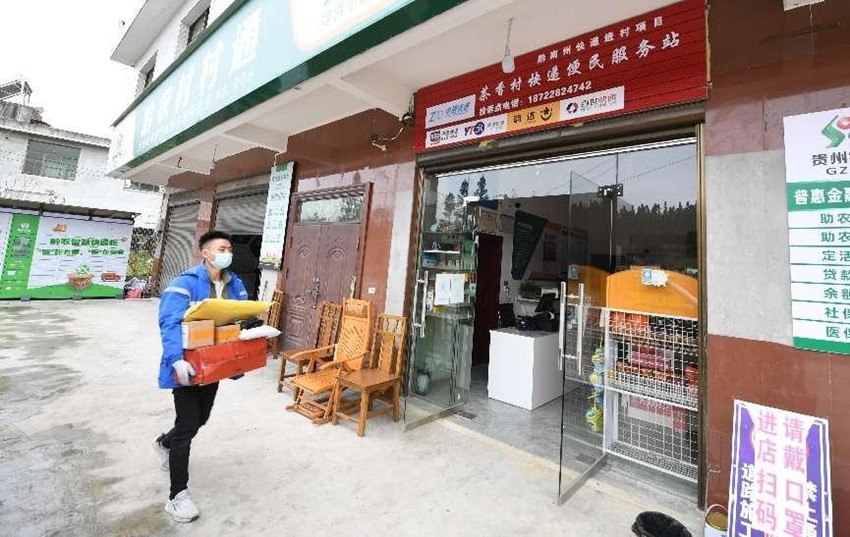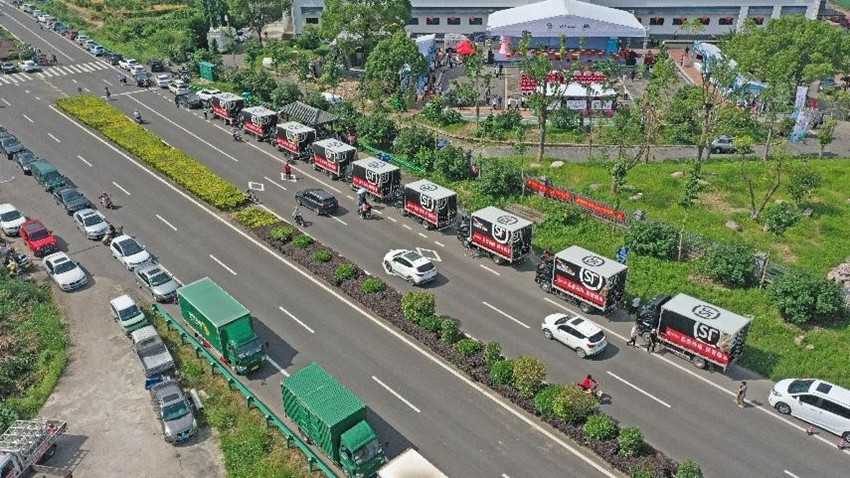Development of rural express industry gives a boost to rural vitalization
Consumption potential of rural China is being constantly released thanks to the rapid development of the express industry.

A courier sends parcels to an express service outlet in Chaxiang village, Gujiao township, Longli county, southwest China's Guizhou province, Nov. 11, 2021. [People's Daily Online/Deng Gang]
The increasingly developed rural express network is leading to smoother logistics in China's countryside, extending online shopping services to more and more rural consumers and making the rural market a new growth pole of the express industry.
As of 2021, express service outlets have been established in over 80 percent of China's villages.
According to recent statistics released by the State Post Bureau, China's express delivery companies handled 51.22 billion parcels in the first six months this year, up 3.7 percent year on year. During the same period, their business revenue increased by 2.9 percent to 498.22 billion yuan ($73.62 billion).
In particular, the share of business volume in central China saw an uplift of 1.1 percentage points, and the figure stood at 0.3 percentage points in the western region.
Rural e-commerce is thriving thanks to expanding express services in rural areas. The prosperous farm produce market and released potential in central China have become a major force driving the growth of the express industry.

Express vehicles gather at Xilu village, Bulu township, Xianju county, Taizhou, east China's Zhejiang province as the harvest season of waxberry arrives, June 9, 2022. [People's Daily Online/Wang Huabin]
The expanding express network brings convenience to rural residents and stimulates consumption potential in rural areas.
In the past, many villagers had to go to townships to send and receive parcels. According to a three-year action plan to extend express delivery to villages released in 2020, express delivery will be available in all qualifying administrative villages by 2022.
Express services have expanded the space of rural development. Relying on the express network, rural e-commerce now enjoys a more solid foundation. More and more agricultural products are entering the urban market, which on one hand meets the demand for individualized consumption, and on the other hand expands the source of income for farmers.
In 2021, 37 billion parcels were collected from and shipped to rural areas across China, facilitating rural-urban commodity exchanges totaling 1.85 trillion yuan.

Photo taken on March 26, 2022 shows a winding road in Yueling village, Daxibian township, Kaihua county, Quzhou, east China's Zhejiang province. [People's Daily Online/Wang Jianlin]
The rural express network, apart from introducing more products to rural areas, is also taking agricultural products to the outside world, thus increasing the income for farmers.
With smoother rural logistics, a new batch of rural industries with local characteristics are emerging, forming a number of influential local brands. They have injected new impetus and energy into the modernization of agriculture and rural areas.
Besides, the development of the rural express industry has created new jobs and new entrepreneurial opportunities. Many couriers working in cities have returned to their hometowns in the countryside to run express delivery spots, which brings new job opportunities to local communities. The emergence of livestream commerce and short video marketing is also building a platform of entrepreneurship for Chinese villagers.
It is believed that as the rural express network further expands, more and more villages will be incorporated into the modern logistics network and embrace new opportunities. A China with smoother logistics is taking shape.
























